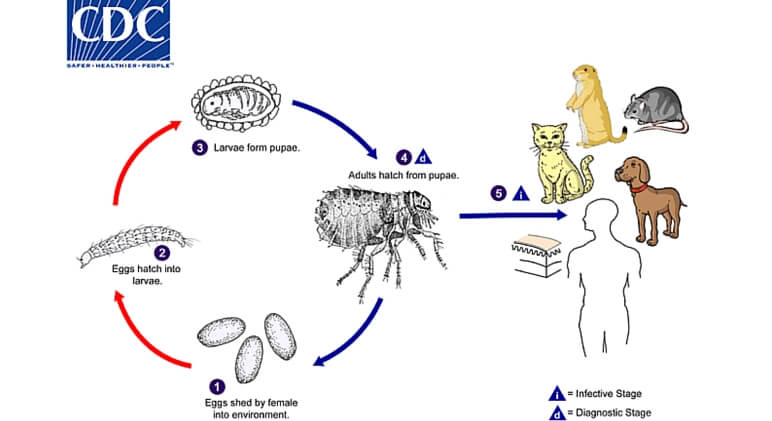Things have been a little hectic in my house the past few days because we’ve been hit with fleas. As I write this post, I must admit I’m a little embarrassed. I’m extremely careful with where I let my pups play and do my best to keep them safe. But we recently took a cross-country car trip to visit family and during our drive we made several stops to let the pups go to the bathroom. During one of those stops, fleas jumped on my dogs. When we got home I noticed my two precious pooches scratching. Then, when I was giving my poodle a belly rub I saw little black “specs” all over her tummy… FLEAS!
Since I didn’t have my dogs on flea prevention (because I try to avoid chemicals as much as possible), you can imagine my worry. Keep reading to find out how fleas can harm your pooch, what to do if you find fleas on your dog, and how to prevent a flea infestation in your home.
A Little About Fleas
Fleas are very small parasites that don’t have any wings and can jump up to eight inches high. They have four life stages: egg, larva, pupa, and adult. Once fleas leave their cocoons and become adults they look for a warm-blooded host (i.e. your pet) to feed off. Shortly after fleas eat their first blood meal, they breed and begin laying eggs in your pet’s fur.
Here’s another scary fact — a single adult female can lay about 40 eggs every day. Just think about that for a second. Once those eggs grow to be adults, they will keep feeding off your dog and reproducing. Plus, depending on environmental conditions, fleas can live anywhere from a couple of weeks to more than a year. So if you don’t kill the fleas ASAP and keep your home clean, you could be in for a real problem.
Why Fleas Are Dangerous To Your Dog
Along with feeding off of your dog’s blood, when a flea bites, it will deposit a small amount of saliva under the skin. Some pets actually develop an allergy to this saliva. This can result in severe itching and skin irritation.
But that’s not all.
Adult fleas can consume as much as 15 times their own weight in blood each day. If fleas suck too much of your dog’s blood, your pooch can develop anemia. A few warning signs of anemia include pale gums and lethargy.
Additionally, your dog could become infected with tapeworms if he/she ingests an infected flea. Along with intense itching around the anus, you may be able to see the tapeworms around your dog’s anus or in his/her feces.
Warning Signs Your Dog Has Fleas
- Intense itching or biting at the skin
- Excessive licking
- Dark specs — or flea droppings — in a dog’s coat (fleas are typically found near the tail, head, neck, and belly so check those areas first.)
- Tapeworm
- Pale gums
What To Do If You Think Your Dog Has Fleas
1) Run a metal flea comb through your dog’s coat
If you see black, dirt-like specs on the comb that aren’t moving, they are probably flea droppings. Veterinarians say this is one of the first signs your dog does indeed have fleas.
If you have live fleas on your comb then make sure to drown them in soapy water before they can jump away.
2) Kill the fleas
Speak with your veterinarian about choosing the right flea treatment. There are a lot of different types of products out there — including topical treatments that are applied to the back of a dog’s neck, chemical shampoos, and chemical sprays.
There are also a number of natural remedies that you can try. For example, many people swear by citrus essential oils and essential oil blends. If you use essential oils to treat fleas make sure to mix it with a carrier oil first. Also, check out this great video by IB Pet for some other natural flea treatment ideas that work:
What I Did In a Pinch:
While I try not to use chemicals on my dogs because I’m personally not a fan of these type of products, I did wind up using a chemical treatment this time around because that’s what I had on hand. Here’s what I did:
I popped my pups in the bathtub at the first sign of fleas. Since fleas die in soapy water I lathered, rinsed, and repeated several times! When bathing to rid your dog of fleas, it’s best to begin by wetting and soaping up the neck area and back of the head. Make sure you get the area around the entire neck (where a collar would go) good and soapy. From there, work your way down the body. Beginning at the neck will keep the fleas from moving up to the face which is much harder to shampoo thoroughly. Take your time, shampoo, and massage so your fur baby gets a really thorough washing. You should see the fleas falling off into the bath water. Make sure the fleas are dead. You don’t want those little guys jumping around your house.
After my dogs dried, since I had a box of Frontline Plus in my pantry for emergency use, I treated with that. The fleas were gone in 24 hours and my dogs stopped scratching.
4) Clean … clean … clean
Since the fleas eggs can fall off of your dog when they are walking or lying down, it’s important to make sure you do a thorough clean of your house. Grab your vacuum and do a thorough clean of your carpets. I vacuumed my rugs twice a day for a week just to be safe! If your vacuum has furniture attachments, run them over your couch too.
Don’t forget to strip the bed and throw all of your sheets, pillowcases, and comforters in the washing machine. Then, throw your dog’s plush toys in the washing machine too. Anything and everything your dogs have touched needs to be cleaned.
Future Prevention
This whole flea experience was definitely a learning lesson for me. While I didn’t have my dogs on any type of flea prevention before, I will certainly be more cautious now. Especially during the hot, humid summer months when fleas thrive!
If you aren’t comfortable with the monthly topical or oral flea prevention recommended by your vet, you can stock up on some of the natural sprays, essential oils, diatomaceous earth, and nematodes mentioned above. Check out the natural recipe by Dogs Naturally in the infographic below:
Good luck!










